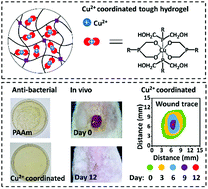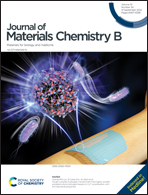Tough complex hydrogels transformed from highly swollen polyelectrolyte hydrogels based on Cu2+ coordination with anti-bacterial properties†
Abstract
The development of broad-spectrum anti-bacterial tough hydrogels without antibiotics remains a challenge in biomedical applications. In this study, we have synthesized a novel tough anti-bacterial complex hydrogel based on Cu2+ coordination. A swollen and weak poly(acrylamide-co-4-vinylbenzyl-(trihydroxymethyl-phosphonium)chloride) (P(AAm-co-VBzTHPC)) hydrogel was prepared by the radical copolymerization of AAm and VBzTHPC monomer solutions, followed by immersion in CuSO4 solution to coordinate with Cu2+ to form a strong and tough hydrogel. Fourier transform infrared (FTIR) spectra and X-ray photoelectron spectra (XPS) were used to characterize the coordination structure between phosphorus and oxygen atoms in the VBzTHPC monomer and copper ions. The water content and mechanical properties of the obtained hydrogel varied with gel composition. The prepared toughened hydrogel exhibited excellent anti-bacterial performance because of the introduction of copper ion coordination and the slow release of copper ions, with bacterial viability of 5.1% when the mole fraction of VBzTHPC was 10 mol%. Cell viability when cocultured with the toughened hydrogel was above 85% using the Cell Counting Kit-8 (CCK-8) method, indicating the good biocompatibility of the hydrogel. Compared with the control group experiment in vivo, this tough hydrogel can also promote wound healing, making it a promising candidate for wound dressing.

- This article is part of the themed collection: Journal of Materials Chemistry B HOT Papers


 Please wait while we load your content...
Please wait while we load your content...